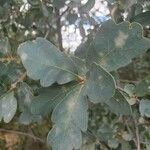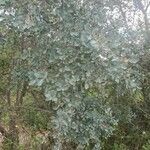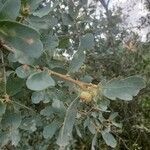Trees , deciduous, with single trunks, sometimes with few to several trunks. Bark gray, scaly. Twigs reddish or yellowish, ca. 2 mm, densely or sparsely puberulent, occasionally glabrate with age. Buds reddish brown, rarely yellowish, broadly ovoid to rarely subglobose, (2-)3-5 mm; scales glabrous except for ciliate margins, sometimes sparsely or densely pubescent. Leaves: petiole blue-green, 2-6 mm. Leaf blade obovate or elliptic, oblong or oblanceolate, (20-)40-60(-80) × (15-)20-30(-40) mm, base rounded-attenuate or rounded, rarely cuneate, margins shallowly lobed or irregularly toothed, sometimes entire, lobes mucronate or rounded, secondary veins 6-10 on each side, apex rounded, rarely moderately acute; surfaces abaxially light green or blue-green, waxy, with scattered to crowded, semi-erect, (2-)4-6(-8)-rayed stellate hairs usually 0.2-0.6 mm diam. or larger, adaxially blue-green, glaucous or grayish, vestiture similar to abaxial surface. Acorns subsessile, solitary; cup hemispheric or cup-shaped, rarely deeper, 5-10 mm deep × 10-15 mm wide, enclosing only base of nut, scales thin and not tuberculate to strongly and irregularly tuberculate, particularly toward base of cup; nut thin-walled, fusiform or subcylindric, 20-30 × 10-16 mm. Cotyledons distinct. 2 n = 24.
More
A large shrub or tree. It grows 21 m high and spreads 6 m wide. It loses its leaves during the year. It has a rounded crown. The bark is thin, grey and scaly. The leaves are bluish and have lobes along the edges. The fruit are cone shaped acorns. They are small and in a shallow hairy cup. The acorns are 2-3 cm long.
Dry soils in valleys, rolling hills and lower mountain slopes; at elevations up to 1,350 metres, often forming extensive stands.
More
It is a temperate plant. Kyneton Botanical Gardens. It suits hardiness zones 6-11.
The acorns are ground into a meal, and used to make soup, bread or biscuits. They are also dried, pounded and leached. They are stored for later use.




